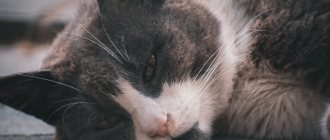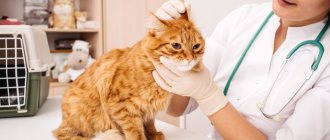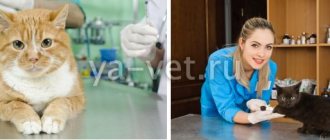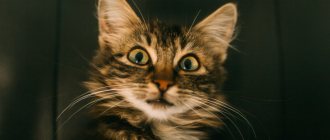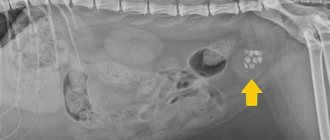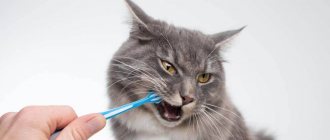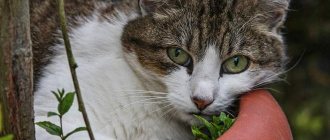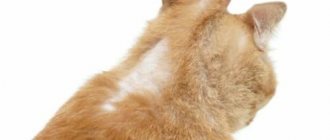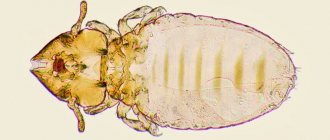An inversion of a cat's eyelid is not always noticeable at first glance. There are various forms of this disease, some of which involve only indirect symptoms, which are not easy to notice. The first symptoms of entropion can be such innocent manifestations as lacrimation and photophobia. However, already at this stage, the pet owner is recommended to play it safe and take the cat to the veterinarian for a general examination. Early contact with a specialist will provide a higher chance of your pet’s subsequent recovery. We will talk further about the reasons for which entropion of the eyelid may develop and which breeds are at risk.
Entropion of a cat's eyelid
What is a turn of the century?
By entropion, veterinarians mean the folding of skin folds inside the eye, which occurs as a result of weakening of the corresponding muscles. This condition is dangerous for the health of the pet, primarily because, along with the eyelid, the hair and eyelashes also change their position, which now come into contact with the cornea of the eye, which is fraught with inflammation.
Entropion of the lower eyelid in a Maine Coon
Volvulus can be expressed to a greater or lesser extent. A mild form of bloat causes periodic but minor discomfort in the cat. The owner may not notice its symptoms at all, since the main manifestation of a mild form is lacrimation. A severe form of entropion of the eyelid sometimes ends in the animal’s blindness if medical assistance is not provided in time.
By the way! It is believed that entropion of the lower eyelid is observed in cats much more often than entropion of the upper eyelid.
Breed influence
It is believed that entropion in cats is largely determined by their breed. Moreover, there are breeds that experience this illness most difficultly and rarely fully recover from it (such as Sphynxes).
Brachycephalic breeds are predisposed to developing entropion
In a physiological sense, cats with brachycephaly are most susceptible to entropion. Among brachycephalic breeds the following breeds are listed:
- Himalayan;
- Persian;
- Scottish;
- Exotic;
- British.
The peculiarity of brachycephals lies in the specific structure of their skull, which gives the impression that the muzzles of representatives of these breeds are slightly flattened. More specifically, the specific physiology of brachycephals is as follows:
- narrowed nostrils;
- elongated soft palate;
- narrowed trachea, as a result of which cats may experience periodic swelling of the soft tissues.
Comparison of the skulls of an ordinary cat and a brachycephalic cat
Owners of brachycephalics need to especially carefully monitor not only the breathing of their pets, but also the condition of the eyes, knowing the weaknesses of the breed.
Volvulus is also typical for Maine Coons, however, these large cats often exhibit milder forms. At the same time, in representatives of the breed, after a cured entropion, eyelashes still sometimes grow ingrown into the eyelid or into the cornea itself.
Video - Maine Coon's turn of the century
Types of entropion
There are two types of entropion depending on the causes of its occurrence:
- primary entropion: is hereditary and is usually found in kittens (before they reach six months of age). It appears due to breed predisposition or improper formation of the fetus. Surgery is prescribed as treatment, however, sometimes primary volvulus goes away without medical help;
Entropion of the eyelid can affect both an adult and a kitten
- secondary entropion of the eyelid: explained by exogenous causes that have nothing to do with the physiology of the cat: various injuries, bruises, unsuccessful operations, etc. A common cause of secondary entropion is also untreated eye diseases, which lead to relapse even after medical correction of the eyelid.
Before selecting the correct treatment regimen, the veterinarian will certainly determine what type of entropion in a particular cat is. Primary and secondary types differ significantly in terms of treatment methods, however, both of them usually involve surgery.
Before making a diagnosis, the doctor carefully examines the cat and prescribes a series of tests.
Prevention measures
There are no ways to independently prevent entropion , since most often the disease is caused by external factors from which a person is not protected in any way.
And you can’t even protect yourself from senile entropion, even if you take care of yourself and try to fight aging.
Attention! Ophthalmologists give recommendations only to stop the progression of the disease. Such indirect preventive measures require constant hygiene when it comes to the organs of vision (especially for those who use contact lenses).
also recommended to regularly moisturize the eyelids using special cosmetics.
With the proper level of hydration, the skin remains elastic for many years, and if you also maintain a healthy lifestyle, there will be no problems with the functioning of internal systems , including the circulatory system.
Namely, it is responsible for keeping the cartilage in good shape to maintain the eyelid and prevent volvulus. And most importantly, you should not ignore the manifestations of any ophthalmological diseases and leave their symptoms unattended.
Symptoms
As already mentioned, entropion of the eyelid can occur in different forms and be either obvious to the owner or hidden. Among the symptoms characteristic of entropion, we list the main ones:
- redness of the eyes, as well as their shine due to lacrimation;
- increased tearfulness;
- moistening and sticking of fur around the eyes;
- change in the shape of the eyes - the eyes become smaller and visually narrower;
- inflammation and swelling of the eyelids/eyelids;
- accumulation of pus in the inner corners of the animal’s eyes;
- redness of the conjunctiva;
- photophobia;
- periodic “wink”;
- Corneal ulcer – typical for severe disease.
One of the sure signs of entropion is avoidance of bright light.
Many inexperienced owners may confuse a mild form of volvulus with conjunctivitis due to the characteristic purulent discharge and try to treat it at home, which will not bring any results and can even be dangerous.
Important! Persians may have the most difficulty experiencing entropion, as this disease may be accompanied by corneal necrosis, leading to serious consequences.
When the eyelid is turned up, the animal sometimes tries to “correct” it with the help of its paws, which should under no circumstances be allowed. A cat runs the risk of introducing bacteria into an inflamed eye, which will further aggravate the course of the disease. In addition, scratching will not relieve your pet of pain, but will only exaggerate it.
Scratching your eyes only makes your cat's condition worse.
Symptoms
How can you tell if your pet needs an urgent visit to the vet? In the initial stages, the cat often begins to “wink” at the owner and avoids looking at light sources. Tears flow profusely from her eyes, and soon the discharge becomes mucous and quite thick. The animal acquires the habit of looking sideways at the world around it. In many cases, the eyelids themselves become inflamed and swollen, and the tissues of the organ become noticeably hot to the touch.
Intolerance to light reaches a peak stage; the animal cannot look at lamps or the sun at all. It begins to constantly rub its eyes with its paws, and this causes it severe pain. If you notice these symptoms in your pet, we advise you to contact your veterinarian immediately.
Diagnostics
If the owner wants to help his cat, then the main thing that is required of him is a trip with the animal to the veterinarian. Any eye washing will not contribute to recovery at all, but can worsen the overall picture. As a rule, the veterinarian quickly makes a diagnosis, since entropion of the eyelid can be visible to the naked eye.
However, to clarify the diagnosis and determine the general health of the animal, the specialist prescribes some related tests:
- general and biochemical blood test;
- Analysis of urine;
- Ultrasound of the abdominal organs;
- electrocardiogram (ECG).
All tests listed by the veterinarian must be taken without fail.
Specifics of analyzes
Owners are often surprised by such a large list of “unnecessary” tests and refuse many of them, since “they have nothing to do with the eyes.” In doing so, they are making a serious mistake. The results of a general examination are important to the veterinarian because entropion itself can be a symptom of some more global, but not yet identified, pathology that suppresses the pet’s immunity. In this regard, in some cases, the cat owner may also be offered a urine test for bacterial culture and even instillation of a special fluorescent agent into the eyes.
When turning the eyelid, it is important for the veterinarian to see the overall picture of the pet’s health
Do not be afraid of such unusual research methods. They are not cheap, but they can guarantee that after eyelid correction it will not sag after a few days or months. In addition, in some cases, during the research process, specialists find the desired pathology in a completely different area (for example, an infectious disease in a latent chronic form). And the animal is cured without surgery. Therefore, you should never rush to put a cat under a scalpel without undergoing a detailed examination.
Good to know
- Plague in cats (diagnosis, treatment, vaccination). How to avoid infecting your pet with feline distemper?
- Feline panleukopenia (etiology, therapy). What to do after panleukopenia?
- Viral Leukemia in Cats (Symptoms, Diagnosis, Treatment, Prevention, Vaccine, Tests for Leukemia in Cats)
- Leptospirosis in cats (etiology, pathogenesis, symptoms, diagnosis, treatment and prevention). Vaccination for leptospirosis
- Viral leukemia in cats (symptoms and treatment). How to help a cat?
- Hemobartonellosis in cats and dogs (epizootology, pathogenesis, diagnosis and treatment). Biological properties of Mycoplasma Haemofelis. Control and prevention measures for hemobartonellosis in cats
- Borreliosis in animals and humans (etiology, diagnosis, spread, causes, therapy, signs and symptoms, prevention). Lyme disease in dogs
- FLV in cats (epizootology, diagnosis and treatment) FeLV for cats (causes, vaccination, prevention and therapy)
- Viral leukemia of cats (etiology, diagnosis, therapy, prevention). What to do if my cat is sick with the leukemia virus
Operation
Despite some cases of non-surgical treatment of pets, surgery is the only solution in the vast majority of cases. The essence of this operation is that the surgeon carefully returns the bent piece of the eyelid to the correct position and secures it with special sutures that will not leave scars on the cat’s face.
Sutures placed on the eyelid during surgery are subsequently removed by a veterinarian
Usually the operation is performed in one go, but if the situation is especially severe, then moving and securing the eyelid can be carried out in several interventions, the number of which is determined by the surgeon after examination.
Preparing for surgery
Any surgical intervention, regardless of its complexity, requires anesthesia, which obliges the owner to follow several strict rules when preparing the pet for surgery. Among these rules are:
- Any food is excluded from the animal’s diet 12 hours (and preferably even 24 hours) before surgery. At the same time, the cat must maintain access to water;
- if the disease is at a severe stage, the damaged cornea of the eye is covered with a third eyelid, which acts as a protective layer;
- the animal's eyes (or eyes) are lubricated with tetracycline ointment and prescribed antiseptic drops are placed. Note that this point does not always take place - it is determined by the veterinarian.
Often, before surgery, the cat is prescribed special antibacterial drops.
Important! Since the cat will be under anesthesia during the operation, it is necessary to first deworm the animal, if possible. Otherwise, the worms may block the animal’s access to oxygen directly during surgery.
After operation
Perhaps the most important question for the owner of a sick pet is what are the cat's chances of making a full recovery? Fortunately, with entropion of the eyelid, the prognosis is very favorable - final cure is achieved in 90 to 95% of animals.
A cat undergoing eyelid inversion surgery
The effectiveness of the operation is influenced by the following factors:
- the cat's health status before surgery - the better the cat feels before surgery, the faster it comes to its senses after its completion;
- age of the pet - young animals tolerate anesthesia and recover on average faster than their more mature relatives;
- breed - as already noted, recovery is the hardest for sphinxes, but there are exceptions;
- the presence of other diseases that weaken the animal’s immunity.
Condition of the animal's eyelid before and after surgery
It should be remembered that the surgeon is not a magician. And even the most successful operation will not be able to bring the cat’s well-being back to normal if it is not taken care of appropriately at home. To help the pet recover completely, the owner must take the following simple steps:
- Put a protective collar on the cat that will not allow him to interact with the eye area. Of course, not every pet will be happy with such an accessory, but this collar is a temporary necessity;
- In the first days, carefully monitor any movements of the pet and do not let him make difficult jumps;
- instill antibiotics in the eyes in the form of drops - this will prevent any development of infection after surgery;
- treat the cat's stitches. The pet owner will learn more about what antiseptic agents are used for treatment and how exactly it is carried out from the attending physician.
You can read below about how to drip or lubricate a cat’s eyes with ointment with minimal damage to yourself and your pet.
How to treat a cat's eyes
In some situations, cats that react violently to anesthesia require sedatives that reduce affect and balance the pets.
Sutures are removed one and a half to two weeks after the operation. It is then that the veterinarian evaluates the final results and draws conclusions about further maintenance therapy.
A protective collar will prevent your pet from introducing infection into the operated eyelids
Treatment
Entropion of the eyelid requires mandatory surgical intervention. Prolonged mechanical irritation can lead to serious complications including blindness and loss of the eye.
There are 2 types of surgery - eyelid surgery and temporary suture for correction. In the second case, the method is used for young animals up to 7 months. Using a special mattress suture, the skin of the eyelids is simply sutured to the lower edge for fixation. This design ensures that entropion does not recur and helps the cat improve his life until the age when it is possible to undergo a full-fledged eyelid surgery. Most often, due to young age and the final formation of the skull, such a suture is sufficient.
